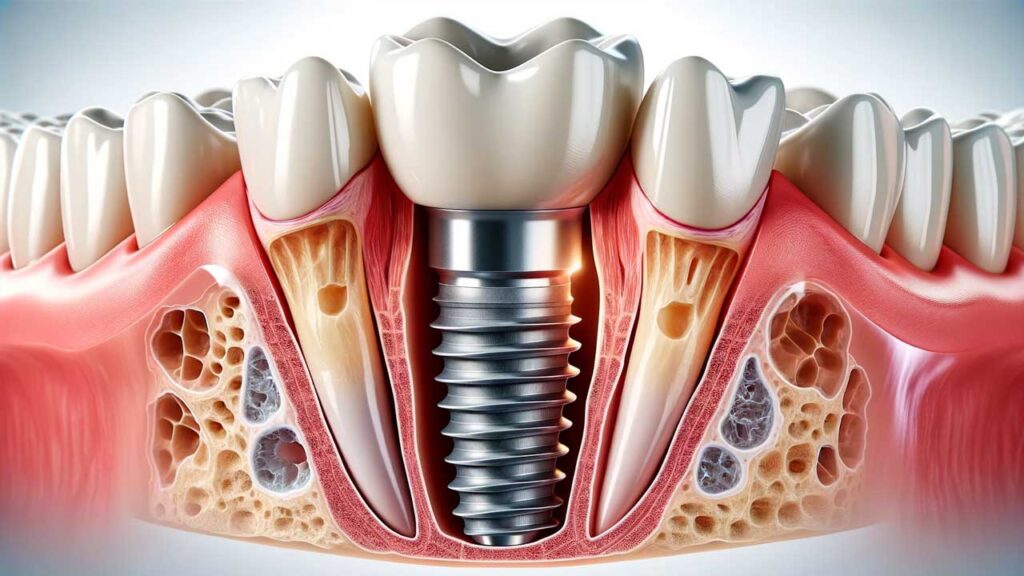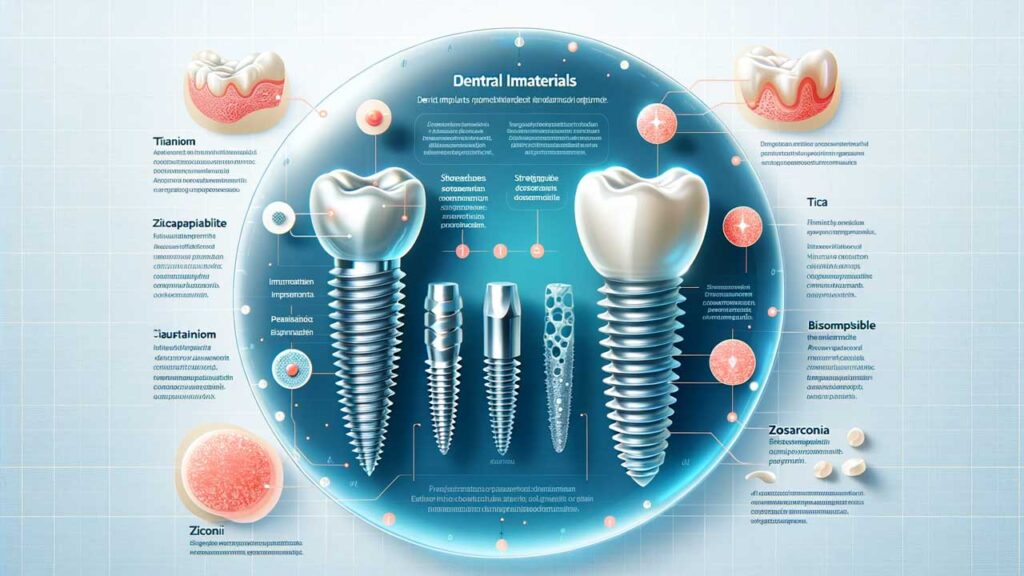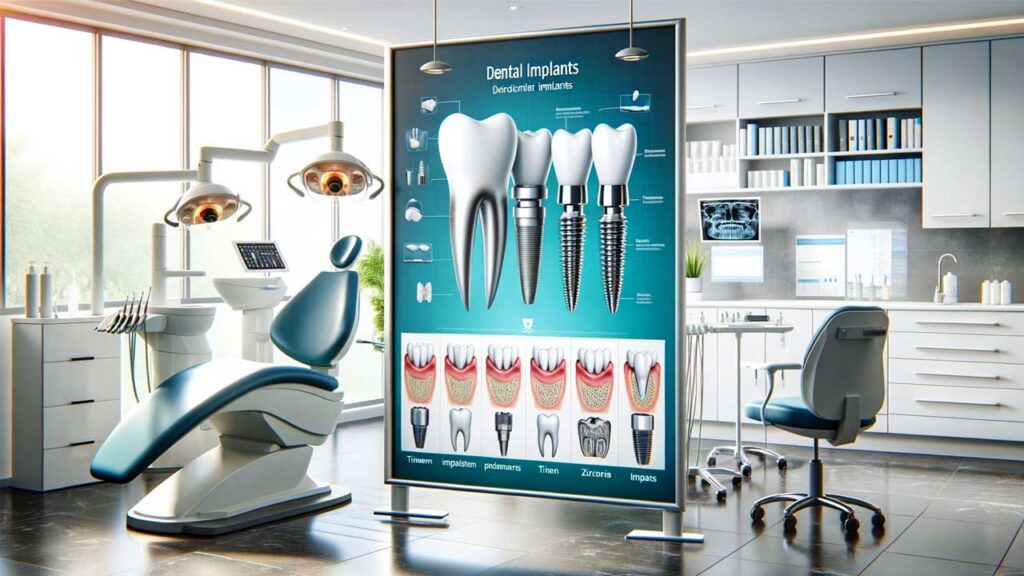In the world of modern dentistry, dental implants have emerged as a groundbreaking solution for replacing missing teeth. But what exactly are these implants made of? This question is not just of interest to those considering implants but also to anyone curious about the advancements in dental technology.
What Are Dental Implants Made Of?
Dental implants, primarily composed of materials like titanium and zirconia, have revolutionized oral healthcare by offering durable, biocompatible, and aesthetically pleasing tooth replacement options.

In this article, we’ll explore the composition of dental implants, delving into the specifics of materials like titanium and zirconia, their benefits in implantology, and how they contribute to the overall success and longevity of dental implants. Understanding the materials and technology behind dental implants not only demystifies the procedure but also highlights the remarkable strides made in enhancing oral health and quality of life.
Dental Implants: An Overview
Definition and Purpose
Dental implants are surgical components that interface with the bone of the jaw or skull to support a dental prosthesis such as a crown, bridge, denture, or to act as an orthodontic anchor. Their primary purpose is to replace missing teeth, thereby improving the patient’s ability to chew and speak, while also preserving facial structure and preventing bone loss.
Historical Development
The journey of dental implants began in the 1950s with the discovery of osseointegration, where bone cells attach directly to a titanium surface, firmly anchoring the implant. This breakthrough paved the way for the modern dental implant, which has undergone continual improvements in design, materials, and surgical techniques, enhancing their success rates and accessibility.
Types of Dental Implants
There are primarily two types of dental implants:
- Endosteal Implants: These are the most common type, surgically implanted directly into the jawbone. Once the surrounding gum tissue has healed, a second surgery is needed to connect a post to the original implant, followed by attaching an artificial tooth (or teeth) to the post individually, or grouped on a bridge or denture.
- Subperiosteal Implants: These consist of a metal frame that is fitted onto the jawbone just below the gum tissue. As the gums heal, the frame becomes fixed to the jawbone. Posts, which are attached to the frame, protrude through the gums for mounting the artificial teeth.
Types of Dental Implants and Their Features
| Type | Material | Placement | Suitable For |
| Endosteal Implants | Titanium, Zirconia | In the jawbone | Patients with a healthy jawbone |
| Subperiosteal Implants | Titanium | On top of the jawbone | Patients with minimal jawbone height |
- Endosteal Implants: Materials – Titanium, Zirconia; Placement – In the jawbone; Suitable For – Patients with a healthy jawbone.
- Subperiosteal Implants: Materials – Mainly Titanium; Placement – On top of the jawbone under the gums; Suitable For – Patients with minimal jawbone height or who cannot undergo a bone augmentation procedure.
What Does Dental Implants Look Like?

Dental implants typically resemble small, screw-like posts. Made of titanium or zirconia, they are designed to mimic the root of a natural tooth. Once implanted, they are not visible, as they are anchored in the jawbone beneath the gum line. The visible part of a dental implant is the crown, custom-made to match the color and shape of surrounding teeth, ensuring a natural and seamless appearance in the mouth.
Detailed Understanding of ‘What Are Dental Implants Made Of’?
Primary Component: Titanium Implants
Properties of Titanium
Titanium is renowned for its strength, durability, and biocompatibility, making it an ideal material for dental implants. It is resistant to corrosion and does not trigger negative reactions when implanted into the body, which is crucial for long-term implant success.
Benefits of Titanium in Implantology
The most significant advantage of titanium implants is their ability to integrate with the jawbone through osseointegration. This process provides a stable and robust foundation for the artificial teeth, ensuring they feel and function almost like natural teeth. Additionally, titanium’s durability means that implants can last a lifetime with proper care.
Titanium vs. Other Materials
While titanium is the gold standard for dental implants, alternative materials like zirconia are gaining popularity. Zirconia offers a metal-free option, which can be preferable for patients with metal sensitivities or aesthetic concerns. However, titanium still leads in terms of flexibility in design and proven track record for long-term success.
Comparison of Titanium and Other Implant Materials
| Material | Biocompatibility | Durability | Track Record | Aesthetic Consideration |
| Titanium | High | Very High | Extensive, well-documented | Less natural for thin gums |
| Zirconia | High | High | Growing, but less than Titanium | More natural, especially for thin gums |
- Titanium: Biocompatibility – High; Durability – Very High; Track Record – Extensive; Aesthetic – Less natural in cases of thin gums.
- Zirconia: Biocompatibility – High; Durability – High; Track Record – Growing, but less extensive than titanium; Aesthetic – More natural, especially in cases of thin gums.
The Emergence of Zirconia Implants
What is Zirconia?
Zirconia, scientifically known as zirconium dioxide, has emerged as a significant material in the dental implant world. Unlike traditional materials, zirconia offers a ceramic-based solution, known for its exceptional strength and durability. It’s a relatively new entrant in the field but has quickly gained popularity due to its unique properties.
Advantages of Zirconia Implants
- Aesthetic Match: Zirconia implants are white, resembling the color of natural teeth, making them an ideal choice for front tooth replacements.
- Hypoallergenic Nature: These implants are a boon for patients with metal allergies, offering a biocompatible alternative without compromising on strength.
- Gum Tissue Response: Zirconia is less conducive to plaque accumulation, promoting healthier gums around the implant site.
- Thermal Insulation: Unlike metal, zirconia does not conduct heat and cold, which can be beneficial for patient comfort.
Comparing Zirconia and Titanium
While titanium has been the cornerstone of dental implants for decades, zirconia offers certain advantages, especially in terms of aesthetics and biocompatibility. However, titanium’s flexibility and proven success rate over the years continue to make it a preferred choice for many dental professionals.
The Process of Osseointegration
Understanding Osseointegration
Osseointegration is the cornerstone of successful dental implantation. It refers to the direct structural and functional connection between living bone and the surface of a load-bearing implant. This process is what makes dental implants so stable and long-lasting.
Role in Implant Stability
Successful osseointegration is essential for implant stability. It ensures that the implant is firmly anchored within the jawbone, functioning similarly to a natural tooth root. This stability is crucial not only for the functionality of the implant but also for the comfort and confidence of the patient.
Factors Affecting Osseointegration
The success of osseointegration depends on various factors:
- Quality and Quantity of Jawbone: Adequate bone density and volume are crucial for implant support.
- Patient’s Health Status: Conditions like diabetes or osteoporosis can impede the healing process.
- Lifestyle Factors: Habits like smoking can significantly affect the healing and integration process.
- Implant Surface Characteristics: The design and material of the implant also play a critical role.
Factors Influencing Osseointegration
| Factor | Impact on Osseointegration | Notes |
| Bone Density | High Impact | Adequate bone density is crucial for implant stability. |
| Overall Health | Variable Impact | Health conditions can influence the healing process. |
| Smoking | Negative Impact | Smoking can delay or impair the osseointegration process. |
| Oral Hygiene | Crucial for Success | Good oral hygiene practices are vital for implant longevity. |
Dental Implant Surgery: Procedure and Care

Preparing for Surgery
Preparation is a critical phase in the dental implant process. It involves a thorough dental examination, possibly including X-rays and 3D imaging, to assess bone quality and plan the implant placement. Patients are also advised about the procedure, including anesthesia options and post-operative care.
The Surgical Procedure
Dental implant surgery is a multi-step process:
- Incision and Access: A small incision is made in the gum to expose the bone.
- Drilling and Placement: A specific drill creates the space in the bone where the implant is placed.
- Closing the Site: The incision is sutured, and the area is left to heal.
Post-operative Care and Maintenance
Post-operative care is crucial for the success of the implant. It involves managing immediate post-surgery symptoms like swelling and discomfort, maintaining rigorous oral hygiene to prevent infection, and attending follow-up appointments to monitor healing and integration.
Dental Prosthesis and Implant Crowns
Types of Dental Prosthesis
Dental prosthesis refers to the artificial replacement of teeth and associated structures. There are various types, including:
- Crowns: Used to cover a single implant.
- Bridges: Span the space where one or more teeth are missing, anchored on either side by dental implants.
- Dentures: Designed to be removable, these can be supported by implants for enhanced stability.
Materials Used in Implant Crowns
The choice of material for implant crowns is vital for both aesthetics and function:
- Porcelain Fused to Metal (PFM): Offers strength and a natural appearance.
- All-Ceramic: Popular for its aesthetic appeal and biocompatibility.
- Metal Alloys: Known for their strength and durability.
The Role of Dental Abutment
The dental abutment is a connector piece placed on the dental implant to hold and support the crown, bridge, or denture. It plays a critical role in ensuring the stability and proper fit of the dental prosthesis.
Bone Grafting and Oral Surgery
Necessity of Bone Grafting
Bone grafting is often required when a patient lacks sufficient bone in the jaw to support dental implants. This procedure involves placing a grafting material in the jawbone to create a more solid base for the implant.
Bone Grafting Materials
Several materials can be used for bone grafting:
- Autografts: Bone taken from the patient’s body.
- Allografts: Donor bone from a bone bank.
- Xenografts: Bone from another species, typically bovine.
- Synthetic Options: Artificial materials that mimic bone properties.
Recovery and Success Rates
The recovery time varies depending on the extent of the grafting. Success rates for bone grafts are generally high, especially with proper post-operative care and maintenance.
Bone Grafting Materials and Their Properties
| Material Type | Source | Properties | Use Cases |
| Autografts | Patient’s own body | Best integration, no rejection risk | Small to medium grafts |
| Allografts | Human donor | Good integration, low rejection risk | Medium to large grafts |
| Xenografts | Animal sources (e.g., bovine) | Slow integration, stable | Large grafts or when autografts are not viable |
| Synthetic | Man-made materials | Variable integration, versatile use | Alternative when natural bone is not an option |
Long-term Care and Maintenance of Dental Implants
Daily Oral Hygiene
Maintaining good oral hygiene is crucial for the longevity of dental implants. This includes regular brushing and flossing to prevent infection and ensure the health of the surrounding gum and bone.
Regular Dental Check-ups
Regular visits to the dentist are essential for monitoring the condition of the implants, prosthesis, and overall oral health. These check-ups help in early detection of any issues that could affect the implant’s longevity.
Managing Implant Longevity
The longevity of dental implants largely depends on proper care and maintenance. Avoiding habits like smoking, maintaining a healthy diet, and addressing any bite issues are also important for ensuring the long-term success of the implants.
Advanced Techniques in Implant Dentistry
CAD/CAM Dentistry and Implants
The integration of Computer-Aided Design and Computer-Aided Manufacturing (CAD/CAM) in dentistry has revolutionized dental implant procedures. This technology enables the design and production of dental restorations, like crowns and bridges, with precise fit and aesthetics. For implants, CAD/CAM technology allows for the creation of customized surgical guides, ensuring precise implant placement and reducing surgery time.
Immediate Load Dental Implants
Immediate load implants are a breakthrough in implant dentistry, allowing for the placement of a temporary tooth during the same appointment as the implant surgery. This technique offers patients the benefit of leaving the clinic with a functional and aesthetic tooth. Ideal for certain cases, it relies heavily on the quality of the jawbone and the technique of the surgeon.
Innovations in Implant Surface Technology
Advancements in implant surface technology focus on enhancing osseointegration. Innovations include the development of nanostructured surfaces and the use of coatings that promote faster and stronger bone integration. These surface modifications aim to improve the stability and longevity of implants, making them a more reliable solution for tooth replacement.
Addressing Common Concerns and Misconceptions
Risks Associated with Dental Implants
While dental implants have a high success rate, like any surgical procedure, they carry certain risks. These include infection at the implant site, injury or damage to surrounding structures, nerve damage, and possible sinus problems when upper jaw implants protrude into sinus cavities. It’s important for patients to discuss these potential risks with their dental professionals.
Debunking Myths About Implants
There are many misconceptions about dental implants that need clarification:
- Myth: Implants are extremely painful.
- Reality: Discomfort is typically minimal and manageable.
- Myth: Dental implants are only for the elderly.
- Reality: Age is not a major factor; overall health is more important.
- Myth: Implants require a lot of maintenance.
- Reality: Implants require similar care to natural teeth.
Cost and Accessibility
The cost of dental implants can vary depending on several factors such as the number of implants, the material used, and additional procedures like bone grafting. While traditionally considered a costly option, the increasing accessibility and financing options are making implants a viable choice for a broader range of patients.
Deep Dives Into Dental Implants
“Cost of Dental Implants”: Financial Considerations
Understanding the cost of dental implants is crucial for those considering this procedure. The price can vary based on factors like geographic location, the expertise of the dentist, and the type of implant used. It’s important to consider the long-term benefits and durability of implants compared to other tooth replacement options.
“Recovery Time for Dental Implant Surgery”: What to Expect
Recovery time varies among individuals but typically involves a few days of rest post-surgery. Patients may experience discomfort, swelling, and bruising, which are normal and manageable with prescribed medication. Complete healing and osseointegration can take several months.
“Advantages of Titanium Dental Implants”: A Closer Look
Titanium implants are known for their strength, biocompatibility, and long history of success. They are less likely to cause allergic reactions and integrate well with the jawbone, providing a stable foundation for replacement teeth.
“Dental Implant Care and Maintenance”: Ensuring Longevity
Proper care and maintenance are key to the longevity of dental implants. This includes regular brushing and flossing, routine dental check-ups, and avoiding damaging habits like chewing hard items or smoking.
“Risks Associated with Dental Implants”: Understanding the Risks
While dental implant surgery is highly successful, there are potential risks such as infection, nerve damage, and implant failure. Choosing a skilled dental surgeon and following their post-operative care instructions can minimize these risks.
“Zirconia vs Titanium Implants”: Making the Right Choice
Zirconia implants offer a metal-free alternative to titanium and are preferred for their aesthetic appeal. However, titanium implants have a longer track record and are known for their flexibility in various surgical procedures.
“Dental Implant Success Rate”: Evaluating the Odds
Dental implants have a high success rate, often above 90%. Factors contributing to success include the quality of the jawbone, the patient’s overall health, and the skill of the dental surgeon.
“Preparation for Dental Implant Surgery”: Steps to Take
Preparation involves a thorough dental exam, possible bone grafting if bone density is insufficient, and discussing anesthesia options. Patients should also arrange for post-surgery rest and help if needed.
“Alternatives to Dental Implants”: Other Options
For those who cannot have implants, alternatives include dentures and bridges. These options can be less expensive but may not offer the same durability or bone preservation benefits as implants.
“Dental Implant Procedures for Elderly Patients”: Special Considerations
Elderly patients can benefit significantly from dental implants. However, their overall health, medication, and jawbone condition need careful evaluation to ensure the success of the procedure.
“Immediate Load Dental Implants”: Exploring the Advantages
Immediate load implants allow for the placement of a temporary tooth during the same appointment as the implant. This can be a convenient option for patients looking for immediate aesthetic improvement.
“Long-term Effects of Dental Implants”: What to Expect
Long-term, dental implants can help preserve jawbone structure, improve oral health, and enhance overall quality of life. With proper care, they can last a lifetime.
Comparison of Immediate Load vs Traditional Dental Implants
| Factor | Immediate Load Implants | Traditional Dental Implants |
| Time to Tooth Replacement | Immediate | Several months |
| Initial Stability Required | Higher | Moderate |
| Ideal Candidates | Limited, depending on bone quality | Broader range of candidates |
| Overall Treatment Time | Shorter | Longer |
In conclusion, dental implants stand as a testament to the incredible advancements in dental materials and techniques. Made primarily from titanium and zirconia, these implants offer a blend of strength, durability, and biocompatibility, making them a preferred choice for tooth replacement. While titanium implants have been celebrated for their robustness and successful track record, zirconia implants are gaining popularity for their aesthetic appeal and hypoallergenic properties. Understanding the composition and benefits of these materials helps patients and practitioners alike appreciate the science and art behind dental implants. As dental technology continues to evolve, the materials used in dental implants will undoubtedly be refined further, continuing to improve the way we restore smiles and enhance oral health.

